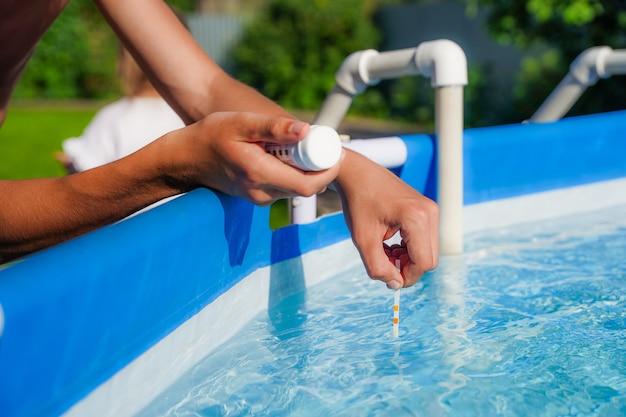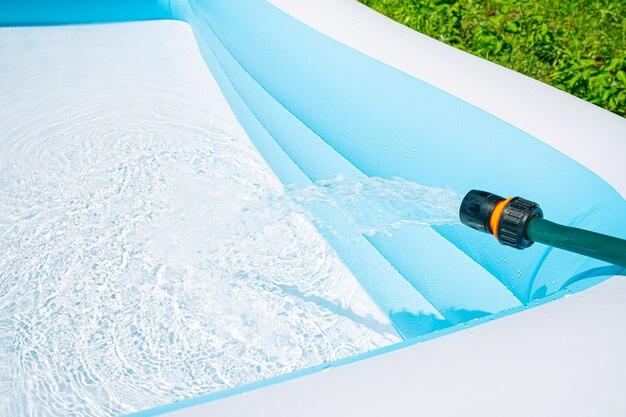If you’re a pool owner, you know that maintaining crystal-clear water involves a delicate balancing act of chemicals. One important component of this balancing act is the use of stabilizer (also known as cyanuric acid or CYA) and chlorine. But, the question often arises: How long do I have to wait after adding stabilizer before I can add chlorine? In this blog post, we will provide you with the answers to this frequently asked question and shed light on other related queries you may have regarding the use of stabilizer and chlorine in your pool.
Many pool owners wonder whether to add chlorine or stabilizer first. We will address this concern as well as provide guidance on the appropriate amount of stabilizer to add for different pool sizes. Additionally, we will tackle the issue of swimming in a pool with low stabilizer levels and explore the potential consequences of adding too much stabilizer. So, if you’re ready to dive into the world of pool chemistry, read on to learn all about the optimal timing for adding chlorine after stabilizer and much more.
How Long After Adding Stabilizer Can I Add Chlorine
If you’re a pool owner, you know that maintaining proper chlorine levels is essential for keeping your pool clean and safe. But what about stabilizer? How long do you have to wait after adding stabilizer before you can add chlorine? Let’s dive into this question and shed some light on the topic!
Understanding Stabilizer
First things first, let’s understand what stabilizer actually does. Stabilizer, also known as cyanuric acid, is added to the pool to protect chlorine from being broken down by the sun’s UV rays. It acts as a shield, prolonging the lifespan of chlorine and preventing it from dissipating too quickly.
The Waiting Game
Now that we know what stabilizer does, it’s time to tackle the question at hand: how long after adding stabilizer can you add chlorine? The answer depends on the type of stabilizer you are using.
If you’re using a liquid or granular stabilizer, you’ll want to wait about 24-48 hours before adding chlorine. This waiting period allows the stabilizer to dissolve completely and distribute evenly throughout the pool. Once it has had time to do its job, you can safely add chlorine to your pool.
On the other hand, if you’re using a stabilizer in the form of a chlorine stabilizing product, such as a stabilized chlorine tablet, you can add chlorine immediately. These types of stabilizers dissolve along with the chlorine tablet, so there’s no need to wait. Just drop in the tablet and watch it do its magic!
Testing and Balancing
While waiting for the stabilizer to do its thing, it’s a good idea to test your pool water to ensure it’s properly balanced. You’ll want to check the pH, alkalinity, and chlorine levels to make sure everything is in line. If any adjustments need to be made, go ahead and take care of them before adding chlorine.
Safety First, Fun Later
When it comes to swimming pool maintenance, it’s important to prioritize safety. Before jumping into your freshly chlorinated pool, make sure the chlorine levels are within the recommended range. This will help ensure a safe and enjoyable swimming experience for you and your loved ones.
So, how long after adding stabilizer can you add chlorine? The answer varies depending on the type of stabilizer you’re using. With liquid or granular stabilizers, give it 24-48 hours before adding chlorine. If you’re using a stabilizing product like chlorine tablets, you can add chlorine immediately. Remember to test your pool water and maintain proper balance for optimal results. Now go ahead, take a dip, and enjoy your well-maintained pool!
FAQ: How Long After Adding Stabilizer Can I Add Chlorine
-
Do I add chlorine or stabilizer first?
It’s recommended to add stabilizer first before adding chlorine. Stabilizer, also known as Cyanuric Acid (CYA), helps protect chlorine from being broken down by the sun’s ultraviolet (UV) rays. By adding stabilizer first, you create a shield that prevents chlorine from dissipating too quickly, allowing it to work effectively in sanitizing your pool. -
Do Clorox chlorine tablets have stabilizer?
Yes, Clorox chlorine tablets do contain stabilizer. These tablets, commonly used in floating chlorinators, are formulated with a balanced amount of both chlorine and stabilizer. They offer the convenience of maintaining a consistent chlorine level while gradually releasing stabilizer to protect the chlorine from getting depleted by sunlight. -
Can you add stabilizer with chlorine?
Yes, you can absolutely add stabilizer and chlorine together. It’s common practice to add stabilizer to the pool water before introducing chlorine. Remember, stabilizer acts as a shield to protect the chlorine, allowing it to stay in the water longer and effectively sanitize the pool. -
How much Stabilizer do I add to my pool?
The amount of stabilizer you should add to your pool depends on the size of your pool and the current CYA level. As a general guideline, for a 20,000-gallon pool, you should add around 4 pounds of stabilizer to increase the CYA level by 20-30 parts per million (ppm). It’s always best to refer to the product label for specific instructions and consult a pool professional for accurate dosage recommendations. -
How long do I wait between adding pool chemicals?
After adding stabilizer to your pool, it’s recommended to wait 4-6 hours before adding any other pool chemicals. This allows the stabilizer to dissolve completely and disperse evenly throughout the water. Waiting for the appropriate time ensures that each chemical has ample time to work effectively and prevents any potential reactions between different chemicals. -
Are chlorine tablets stabilized?
Yes, chlorine tablets commonly available in the market are often stabilized. Stabilized chlorine tablets contain both chlorine and stabilizer (CYA) in their composition. By using stabilized chlorine tablets, you not only chlorinate your pool but also introduce a certain amount of stabilizer to maintain chlorine effectiveness. -
Can you swim in a pool with low stabilizer?
Swimming in a pool with low stabilizer is safe, but it’s important to ensure that the chlorine levels are properly maintained. Without a sufficient amount of stabilizer, chlorine will break down quickly under the sun’s UV rays, reducing its ability to effectively sanitize the pool water. Regularly monitoring and adjusting chlorine levels becomes even more crucial in a pool with low stabilizer. -
How do you use chlorine stabilizer?
Using chlorine stabilizer is easy! First, determine the recommended dosage by referring to the product label or consulting a professional. Typically, stabilizer is added directly to the pool water. It can be broadcasted over the surface or dissolved in a bucket of water and poured evenly around the pool. After application, it’s essential to circulate the water to help the stabilizer disperse evenly and fully dissolve. -
How much stabilizer do I need for a 20,000 gallon pool?
For a 20,000-gallon pool, you will need about 4 pounds of stabilizer to increase the CYA level by 20-30 ppm. However, it’s crucial to check the specific product instructions and consult with a pool professional to determine the precise dosage for your particular pool, as different products may have slightly different concentration levels. -
Do you add stabilizer to the skimmer?
No, it is not recommended to add stabilizer directly to the skimmer. Stabilizer should be added to the pool water by broadcasting it evenly across the pool’s surface or dissolving it in a bucket of water and pouring it around the pool. Adding stabilizer to the skimmer can cause clogging and prevent proper circulation, leading to inefficient distribution of the stabilizer throughout the pool. -
How long after stabilizer can I shock the pool?
After adding stabilizer to your pool, it’s recommended to wait at least 24 hours before shocking the pool. This allows ample time for the stabilizer to dissolve and distribute evenly throughout the water. Waiting before shocking ensures the effectiveness of the shock treatment and prevents any potential reactions between the two chemicals. -
What happens if you put too much stabilizer in a pool?
Adding too much stabilizer to your pool can result in excessive levels of CYA, which can interfere with chlorine’s ability to sanitize effectively. When the CYA level is too high, chlorine becomes significantly less active, leading to reduced effectiveness in killing algae and bacteria, resulting in cloudy water and potential health risks. To avoid this, always follow the recommended dosage and regularly test and adjust chemical levels as needed. -
How long after using CYA can you add chlorine?
After using CYA (stabilizer), it’s best to wait for approximately 24-48 hours before adding chlorine to the pool. This waiting period allows the stabilizer to fully dissolve and distribute evenly throughout the water, ensuring that the added chlorine remains protected and effective in sanitizing the pool. -
Can you add stabilizer and clarifier at the same time?
It is generally recommended to add stabilizer and clarifier separately and at different times. Stabilizer should be added first, allowing it to dissolve and distribute evenly before introducing any other chemicals. Clarifier, on the other hand, is typically added directly to the pool water with the filtration system running. By adding these chemicals separately, you ensure the effectiveness of each product and avoid any potential interactions or interference between them. -
Does pool stabilizer evaporate?
No, pool stabilizer (CYA) does not evaporate from the pool water. However, it can gradually degrade over time due to the effects of UV sunlight exposure. Regularly testing the CYA levels and replenishing it as needed will help maintain the optimal amount of stabilizer in your pool, ensuring the effectiveness of chlorine and prolonging its lifespan. -
How long should I leave chlorine floater in the pool?
Chlorine floaters are handy devices that gradually release chlorine into the pool water. The duration for leaving a chlorine floater in the pool can vary depending on the floater’s size and the pool’s chlorine demand. It is generally recommended to check and adjust the chlorine levels regularly and refill the floater as needed to maintain a consistent chlorine concentration in the water. -
Is chlorine stabilizer the same as chlorine tablets?
No, chlorine stabilizer is not the same as chlorine tablets. Chlorine stabilizer, also known as CYA, is a chemical compound that helps protect chlorine from UV degradation. Chlorine tablets, on the other hand, are a form of chlorine that slowly dissolves to sanitize the pool water. Some chlorine tablets may contain stabilizer, but they are not the same thing. It’s important to differentiate between the two and understand their individual functions in maintaining a healthy pool.

